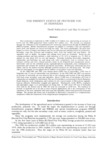The Present Status of Pesticide Use in Indonesia
Tropical agriculture research series : proceedings of a symposium on tropical agriculture researches
| ISSN | 03889386 |
|---|---|
| 書誌レコードID(総合目録DB) | AA00870529 |

本文フルテキスト
tars16-_15-23.pdf1.43 MB
Rice production in Indonesia in 1981 totalled 21.9 million tons, representing an increase of 8.12% over the 1980 production which reached 20.3 million tons. The increase was obtained through the utilization of the recommended new technology implemented through the BIMAS and INSUS programs. Similar intensification program was applied to secondaiy crops and vegetables. Insect pests and diseases are factors lowering the yield. The brown planthopper, the green leafhopper as vectors of tungro virus disease and rats are still important limiting factors for production. Secondary crops like soybeans and mungbean suffer from leaf feeders and pod feeders. On vegetables such as shallot, red pepper and cabbage insect pests are dominant. Weeds are also creating problems and data indicate a yield reduction of 25-35% in irrigated rice, 75-90% in upland rice and about 45% in corn and legumes. Pesticides including insecticides, fungicides,
rodenticides and herbicides are used along with other components, such as extensive use of resistant cultivars and strict cultural practices based on the integrated pest management system. Insecticides used are the carbamate group, organophosphorus compounds, some combinations of insecticides and recently the synthetic pyrethroid insecticides. Brodifacou.ri rodenticide has been widely used by the fanners recently although coumarin products are still being uSed. The fungicides are used mainly on corn against downy mildew, on secondary crops and vegetables.
In the 1980/1981 and 1981 crop seasons about 9,000 tons of insecticides, 2,500 tons of fungicides and 75 tons of rodenticides were distributed. In the 1981/1982 and 1982 crop seasons an increase of insecticide use was observed due to the extension and increase of the area planted with food crops, secondary crops and vegetables. About 15,000 tons of insecticides, 433 tons of rodenticides are available for distribution. The use of herbicides is concentrated in North Sumatera, South Sulawesi, Aceh, Kalimantan and Lombok for the control mainly of Monochon·a vagina/is, Cyperus diformis, Echinochloa crnsgalli and spikerush. Thiobencarb, 2,4-D, MCPA, oxadiazon and piperophos singly or as combinations are being used. In 1981 about 350 tons of herbicides were used by the farmers and in 1982 the total use increased to 1,618 tons. The tendency of increase of pesticide use is not due to more frequent applications, but is the consequence of the expansion of the area cultivated with food crops and vegetables, which needs protection from pest damage. The present and future role of pesticides in Indonesia is conceived as a complementary component within the framework of the integrated pest management system.
rodenticides and herbicides are used along with other components, such as extensive use of resistant cultivars and strict cultural practices based on the integrated pest management system. Insecticides used are the carbamate group, organophosphorus compounds, some combinations of insecticides and recently the synthetic pyrethroid insecticides. Brodifacou.ri rodenticide has been widely used by the fanners recently although coumarin products are still being uSed. The fungicides are used mainly on corn against downy mildew, on secondary crops and vegetables.
In the 1980/1981 and 1981 crop seasons about 9,000 tons of insecticides, 2,500 tons of fungicides and 75 tons of rodenticides were distributed. In the 1981/1982 and 1982 crop seasons an increase of insecticide use was observed due to the extension and increase of the area planted with food crops, secondary crops and vegetables. About 15,000 tons of insecticides, 433 tons of rodenticides are available for distribution. The use of herbicides is concentrated in North Sumatera, South Sulawesi, Aceh, Kalimantan and Lombok for the control mainly of Monochon·a vagina/is, Cyperus diformis, Echinochloa crnsgalli and spikerush. Thiobencarb, 2,4-D, MCPA, oxadiazon and piperophos singly or as combinations are being used. In 1981 about 350 tons of herbicides were used by the farmers and in 1982 the total use increased to 1,618 tons. The tendency of increase of pesticide use is not due to more frequent applications, but is the consequence of the expansion of the area cultivated with food crops and vegetables, which needs protection from pest damage. The present and future role of pesticides in Indonesia is conceived as a complementary component within the framework of the integrated pest management system.
| 刊行年月日 | |
|---|---|
| 作成者 | Dandi SOEKARNA Mas SUNDARU |
| 公開者 | Japan International Research Center for Agricultural Sciences |
| 巻 | 16 |
| 開始ページ | 15 |
| 終了ページ | 23 |
| 言語 | eng |
